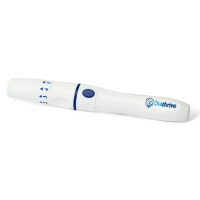Lancing Device
Make checking your blood sugar easy and painless with our lancing device. With 5 depth setting options, you can find the perfect setting for your needs and maximize comfort. So whether your skin is thick and rough, thin and soft, or anywhere in between, our lancing device can help you get the blood sample you need to check your blood sugar.
The Diathrive Lancing Device has a strong spring to ensure quick action and reduce the need for extra lancing attempts.
Diathrive Glucose Meters are FDA-approved for Alternate Site Testing (AST), and our lancing device comes with a regular cap for fingertips and a separate cap designed for use on alternate testing sites.
Get this lancing device for FREE with a Diathrive Subscription Plan
What is a Lancing Device?
Lancets are small and can be hard to hold for some people. Lancing devices are used to help make using a lancet easier.
The device looks like a broad pen with a dial on the end. The lancing device holds the lancet, and when you press the trigger button, the device quickly deploys the lancet to prick the skin. The lancing device makes sure the prick is the same every time and can be adjusted to change the depth in which the lancet goes into your skin.
How to Use a Lancing Device
- Wash and dry your hands thoroughly. This will prevent contamination of the blood you are testing.
- Unscrew the cap counter-clockwise from your lancing device and insert the lancet. Carefully twist the end of the lancet and pull straight off to avoid bending the metal. Set the piece of round, blue plastic aside for later. Screw the cap back on clockwise. Don't over-tighten or the device may crack.
- You can adjust the lancing depth by twisting the end of the cap, lining the arrow up with a number. The higher the number, the deeper the lancet will go into your skin.
- Get your meter and test strip ready. Make sure the strip and blood drop icon is showing on your meter's screen before attempting to add a blood sample.
- Pull back on the lancing device to load it. Press the tip of the device lightly against the side of your finger near the tip and press the blue button. This will puncture your skin. Squeeze gently to draw a drop of blood and apply to the tip of the test strip’s sample port. Use an alcohol swab to wipe the leftover blood from your finger to keep it clean and reduce the risk of infection.
- Remove the cap from the lancing device and stick the exposed needle into the blue tip you removed from your lancet to cover the exposed needle. Dispose of the used lancet properly in a sharps container.
Alternate Site Testing (AST)
Although blood from fingertips will provide the most consistently accurate results, some people find it more painful because there are more nerve endings in the fingers. When reducing pain is prioritized, these people may choose to try AST. If you plan to draw your blood sample from somewhere other than your fingertip, use the clear cap that comes with your Diathrive Lancing Device. It has a larger opening and is designed for drawing blood from other areas. FDA-approved areas for alternate site testing include:
- Palm
- Forearm
- Upper arm
- Legs
- Abdomen

